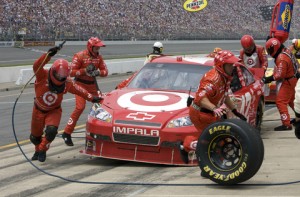While sitting through a presentation by the Medici Group last Friday, one of the slides caught my eye.
Franz Johanssen, an international management consultant whose workshop helps companies innovate through the “intersection of ideas, concepts and culture,” gave a stunning presentation.
As we often do, sitting though presentations, there are times that our mind just wanders. We sometimes have so many other thoughts pushing through our space that we are there and at the same time we are not there.
The slide was the photo of a pit stop. I must confess that I am not a fan of car racing by any stretch of the imagination, but this slide really got me to thinking.
Organized mayhem
As the presentation proceeded, this particular slide would not let me go. If I could name this slide I would call it “organized mayhem.” A pit stop to me is at the intersection of both organization and chaos. But in this case, every movement is planned.
Those of us who are organizational development professionals tend to look at issues from an organization perspective, trying to bring clarity to chaos. Therefore, I saw beauty in this photo — and that is what really intrigued me.
I remember reading a few years back about a new idea in training and development using the pit stop concept as a team building exercise. The entire learning exercise is built around having your team learn the theory behind the pit crew. Exercises are designed around energizing, valuing teamwork, communication, and the inter-connectivity of the team.
The executive team as the pit crew
I thought, “why not use the race car as a metaphor for the organization?”
Depending on the type of race — Nascar, Formula, 1 or Indy Car series — the structure of the pit crew changes. Pit stop work is carried out by anywhere from five-20 individuals, each one a specialist in performing their duties but working together as the ultimate team. In fact, pit stop strategy has become one of the most important components of the racing strategy.
In corporations, the executive suite is comprised of business unit head that plans the velocity of the company. Strategy is planned yearly with planning sessions throughout the year.
The model that I thought of was the car as the organization with each specialist represented in the pit crew. This would be the theoretical pit crew of the organization. This car could also serve as the metaphor for departments as well as the team.
From the boardroom to the mailroom
This team with their specialized training could give the organization a more intense focus during their planning session. Planned reviews would bring EVERYONE to the table to discuss performance and how the organization is moving forward.
 These sessions (and their findings) could them be pushed out into the organization to each department using the same pit crew methodology to discuss how each respective department is performing in alignment with the larger organizational goals. This should also trickle down from the departments to individual teams, with each unit focusing on their areas of expertise.
These sessions (and their findings) could them be pushed out into the organization to each department using the same pit crew methodology to discuss how each respective department is performing in alignment with the larger organizational goals. This should also trickle down from the departments to individual teams, with each unit focusing on their areas of expertise.
This would create not only a strategic funnel but a communication model that would get the entire organization involved with corporate goals and strategy.
I’m a big fan of earnings calls, and I will always listen to calls for the companies that interest me. But, I also know from my corporate experience that as the team prepares for these calls, the focus is all about getting the correct message out to the street. Meanwhile within the organization, employees are provided a link or can listen at their own leisure to the call.
There has never been, at least in my experience, any concentrated effort to engage everyone in this most important piece of corporate communications. Imagine if this same intensity that goes into the planning of an earnings call was used to have a quarterly conversation, with all employees on deck, discussing where we are as an organization, where we are headed, and how we plan to get there..
The new transparency
The strategy in car racing is to have planned and scheduled pit stops. How many pits stops, and when they should occur, is always crucial to a race. Pit teams also take competitors strategy into account when planning their pit stops.
Going forward, this quarterly review model would not only be about strategic advantage but also about real teamwork, real communication, real engagement, real trust, and real motivation. These are all real issues (and symptoms) of the low engagement levels that companies are faced with today.
This could be the beginning of the dismantling of the silo enterprise and a transition to the networked enterprise. This would surely change my pet theme of HR 3.0 to the Strategic Enterprise 3.0. This model would lead to the ultimate off-site meeting for the entire organization.
Let 2010 and before, with the old ways that strategy was developed and reviewed, represent a passing of the torch. This would be the demarcation line between what was, and what will be, in the organization.
